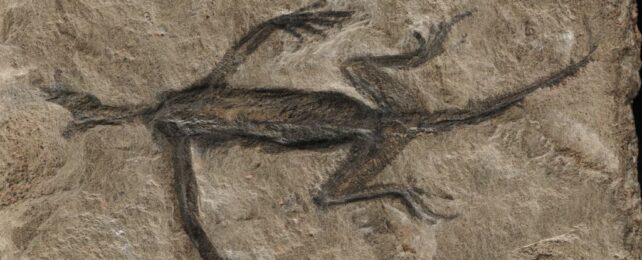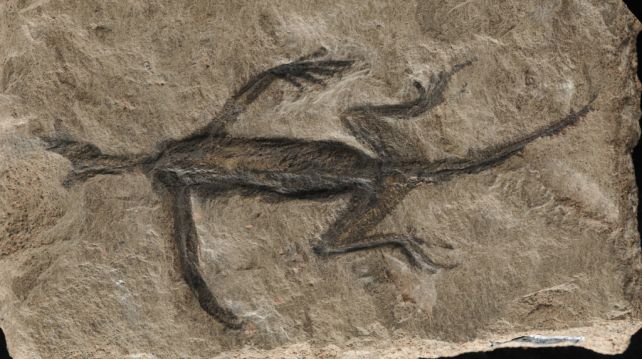ARTICLE AD
 The celebrated Tridentinosaurus fossil. (Dr Valentina Rossi)
The celebrated Tridentinosaurus fossil. (Dr Valentina Rossi)
In the 90-odd years since it was discovered, we've never found anything like an ancient, early Permian fossil discovered in the Italian Alps.
It's called Tridentinosaurus antiquus, excavated in 1931, and considered a truly remarkable find. Dating to 280 million years ago, before the dinosaurs, it was thought to represent one of the oldest lizard fossils ever found.
Even more excitingly, its preservation was exceptional: an imprint of the animal's body outlined in preserved soft tissue.
Well, now we know why we've never found another fossil like it: that soft tissue, according to a new, painstaking analysis, is not soft tissue at all. It's paint.
The discovery was made by a team led by paleobiologist Valentina Rossi of University College Cork, who uncovered the devastating ruse while conducting a study of the unusual remains.
"At first glance I must say I thought the fossil was looking a bit… peculiar," Rossi tells ScienceAlert.
"Other colleagues of mine told me they had the same reaction. But fossils are always a bit weird, so I carried on my research and after analyzing microsamples of what looked like the body outline (so, the skin) I realized that nothing made sense. The molecular analyses finalized the results that what we had was not carbonized soft tissue, but black paint."
Tridentinosaurus has been something of a fossil celebrity for a long time. Soft tissue is rarely preserved; it usually decomposes before the long fossilization processes can record its imprint.
When it is preserved, it can tell us things about the animal it belonged to – the color and texture of its skin, for instance, and even the arrangement of its anatomy and internal organs.
Scientists had come up with theories about how the soft tissue of Tridentinosaurus had been preserved, but no one had studied the skin in detail. This is why Rossi and her colleagues decided to take a closer look.
 Tridentinosaurus antiquus. (Dr Valentina Rossi)
Tridentinosaurus antiquus. (Dr Valentina Rossi)An initial UV scan revealed a coating over the entire fossil. This has been standard in the past to preserve delicate structures and is still sometimes done for particularly fragile specimens. However, what was under the coating required more detailed analysis.
The team used a combination of scanning electron microscopy coupled with energy dispersive spectroscopy, micro-X-ray diffraction, and Raman and Attenuated total reflectance - Fourier transformed infrared spectroscopies to analyze the black material thought to be carbonized skin.
They compared their results against a number of materials. The sample was consistent, not with organic material, but a manufactured bone black pigment often seen in historical paintings.
The discovery was extremely unexpected, and the researchers were pretty rattled. But there is a silver lining.
"I think I can honestly say we were all a bit in shock and sad," Rossi recalls, "but we realized that this is a glimpse in the history of paleontology. Today we can count on powerful techniques that allow us to look at fossils at the molecular level, and this was not possible even 10 years ago."
Also, while the 'skin' may have been faked, parts of the fossil are genuine. The rear leg bones over which the skin was painted are real, in particular the femurs. It will be tricky to study these bones under the paint, although 3D imaging will be able to help.
This means that researchers can work to understand the real Tridentinosaurus, even comparing it to other fossils that previously may have been dismissed as too dissimilar to represent the same species or genus.
Paleontologists could also revisit the site at which the fossil was found, looking for new specimens, possibly in a better state of preservation.
The research may have revealed Tridentinosaurus's major secret – but one glaring one remains.
"We don't know who did it and we don't know why," Rossi says.
"We think that since part of the bones are visible, as well as tiny bony scales, someone thought to try to excavate in places where they thought other bones might be. The paint was perhaps applied to embellish the specimen."
To this question, however, we probably never will have an answer.
The research has been published in Palaeontology.

 1 year ago
110
1 year ago
110 

